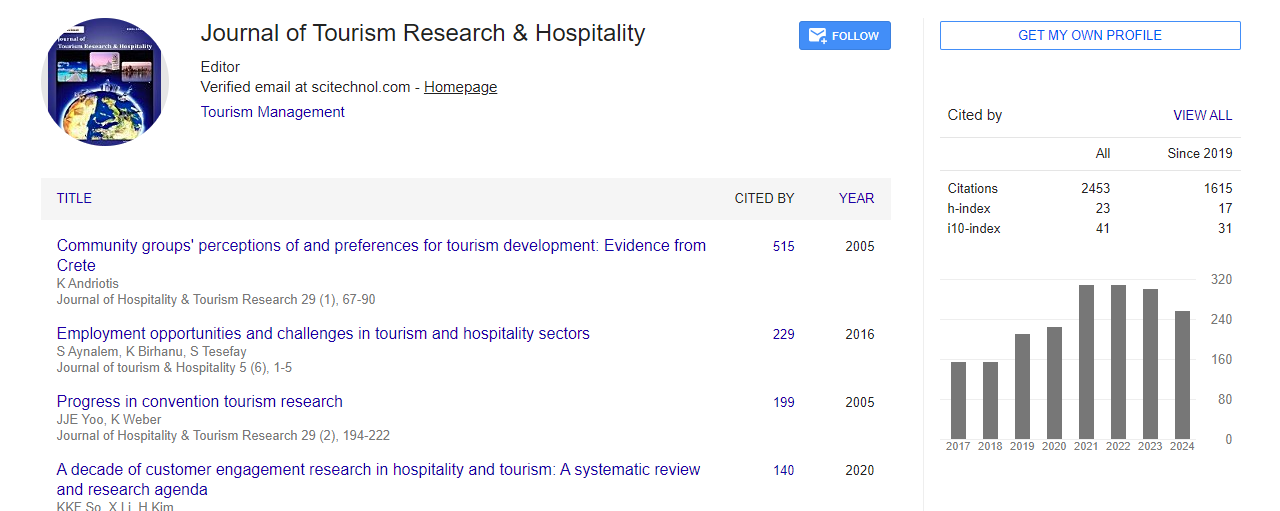Perspective, J Tourism Res Hospitality Vol: 13 Issue: 2
Heritage Trails: Exploring Cultural Diversity in Tourism
Jihyo Park*
1Department of Geography and Environmental, University of Waterloo, Waterloo, Canada
*Corresponding Author: Jihyo Park,
Department of Geography and Environmental,
University of Waterloo, Waterloo, Canada
E-mail: anne.jason@gmail.com
Received date: 26 March, 2024, Manuscript No. JTRH-24-136586;
Editor assigned date: 28 March, 2024, PreQC No. JTRH-24-136586 (PQ);
Reviewed date: 15 April, 2024, QC No. JTRH-24-136586;
Revised date: 22 April, 2024, Manuscript No. JTRH-24-136586 (R);
Published date: 29 April, 2024, DOI: 10.4172/2324-9110.1000176
Citation: Park J (2024) Heritage Trails: Exploring Cultural Diversity in Tourism. J Tourism Res Hospitality 13:2.
Description
Cultural tourism is a vibrant and multifaceted sector that celebrates the diversity of human heritage, traditions, and creativity. It offers travelers the opportunity to immerse themselves in the unique cultures, histories, and customs of destinations around the world, promote cross-cultural understanding, appreciation, and dialogue. In this study begin on a journey through the enchanting field of cultural tourism, exploring its significance, attractions, challenges, and opportunities for sustainable development.
Understanding cultural tourism
Cultural tourism encompasses travel experiences that focus on the exploration, appreciation, and interpretation of cultural heritage and traditions. It includes a wide range of activities, such as visiting museums and historical sites, attending cultural festivals and events, participating in culinary tours and workshops, and engaging with local communities and artisans. Cultural tourism not only enriches the traveler’s experience but also contributes to the preservation and promotion of cultural heritage and identity. Cultural tourism plays a important role in promoting cross-cultural understanding, tolerance, and appreciation among people from different backgrounds. It helps to preserve and safeguard cultural heritage, traditions, and languages, ensuring their continuity for future generations. Cultural tourism also contributes to economic development by creating employment opportunities, supporting local businesses, and generating revenue for communities.
Types of cultural tourism attractions
Cultural tourism attractions come in various forms, each offering unique insights into the cultural fabric of a destination. Historical landmarks, such as ancient ruins, castles, and archaeological sites, provide glimpses into the past and the civilizations that once thrived there. Museums and art galleries showcase the artistic and cultural achievements of societies throughout history, displaying artefacts, artworks, and cultural relics. Cultural festivals and events celebrate local traditions, rituals, and customs, inviting visitors to join in the festivities and experience the vibrancy of community life.
Sustainable cultural tourism development
Sustainable cultural tourism development seeks to balance the preservation of cultural heritage with the socio-economic needs of local communities and the conservation of natural resources. It involves strategies such as visitor management, cultural heritage conservation, community engagement, and responsible tourism practices. By promoting partnerships between stakeholders, implementing carrying capacity limits, promoting cultural sensitivity and respect, and investing in community-based tourism initiatives, destinations can ensure that cultural tourism contributes to long-term social, economic, and environmental sustainability.
Community empowerment is a central tenet of sustainable cultural tourism development, ensuring that local residents have a voice in tourism decision-making and benefit directly from tourism activities. Community-based tourism initiatives empower local communities to showcase their cultural heritage, traditions, and craftsmanship, providing opportunities for cultural exchange, economic diversification, and socio-cultural enrichment. By involving communities in tourism planning, training local guides and artisans, and promoting cultural pride and identity, cultural tourism can become a powerful tool for community development and empowerment.
Preserving cultural heritage is essential for maintaining the authenticity and integrity of cultural tourism destinations. Heritage conservation efforts involve the restoration, protection, and interpretation of historical sites, monuments, and artefacts, ensuring their longevity and accessibility for future generations. Cultural tourism can support heritage conservation through revenue generation, public awareness campaigns, and community engagement initiatives. By promoting sustainable tourism practices and responsible visitor behavior, cultural tourism can help safeguard cultural heritage for the enjoyment and enrichment of present and future generations.
Cultural tourism and cross-cultural exchange
Cultural tourism fosters cross-cultural exchange and dialogue, facilitating interactions between travelers and local communities, artisans, and cultural practitioners. Through immersive experiences such as home-stays, cultural workshops, and guided tours, travelers gain insights into different ways of life, beliefs, and traditions, challenging stereotypes and promoting empathy and understanding. Cultural tourism promotes intercultural dialogue, respect, and appreciation, breaking down barriers and building bridges between people from diverse backgrounds.
Conclusion
Cultural tourism offers a window into the soul of humanity, celebrating the richness, diversity, and strength of cultures around the world. By embracing the principles of sustainability, community empowerment, and heritage conservation, cultural tourism can become a powerful force for positive change, enriching lives, preserving traditions, and promoting cross-cultural understanding and harmony. As we continue to explore and engage with the cultural treasures of our planet, let us do so with reverence, humility, and a spirit of curiosity and respect for the communities and heritage that welcome us.
 Spanish
Spanish  Chinese
Chinese  Russian
Russian  German
German  French
French  Japanese
Japanese  Portuguese
Portuguese  Hindi
Hindi 

